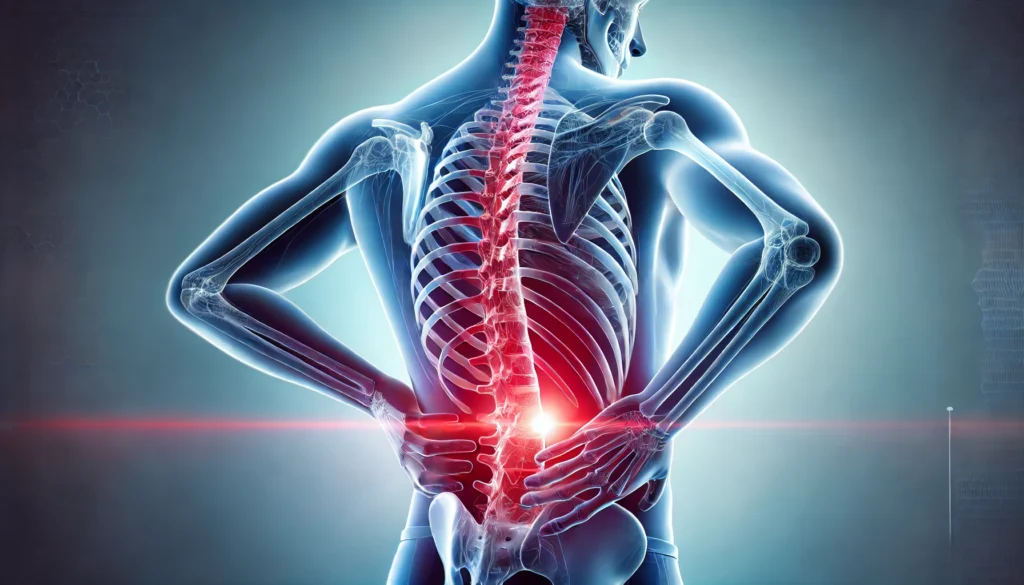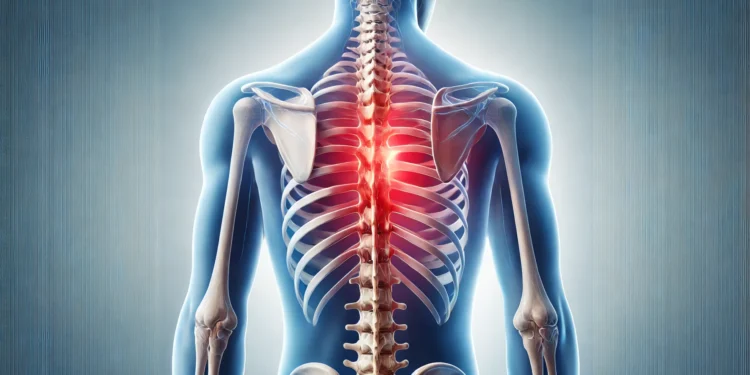Middle back pain around the rib cage is a common discomfort that many people experience at some point in their lives. The middle back, located between the upper and lower back, plays a crucial role in supporting the spine and maintaining posture. Pain in this area, especially around the rib cage, can vary in intensity and may be caused by a variety of factors. In this article, we will explore the potential causes of middle back pain around the rib cage, how to identify the symptoms, and what treatment options are available.
What Is Middle Back Pain Around the Rib Cage?
Middle back pain refers to discomfort in the area between the upper and lower back, often affecting the thoracic spine. This region also houses the rib cage, which is why pain can sometimes feel localized around the ribs. The pain can range from mild soreness to sharp, stabbing sensations, and it may radiate toward the front of the chest or abdomen.
Read Also: Car Accident Back Pain – Back Discomfort from a Car Accident!
Common Causes of Middle Back Pain Around the Rib Cage
Several factors can contribute to middle back pain around the rib cage. Here are some of the most common causes:
1. Muscle Strain or Sprain
- One of the most common causes of middle back pain is muscle strain or sprain. Overexertion, improper lifting, or sudden movements can cause the muscles in the middle back to stretch or tear, leading to pain. This can also affect the muscles surrounding the ribs, causing discomfort around the rib cage.
2. Poor Posture
- Maintaining poor posture, such as slouching or sitting for extended periods, can put strain on the muscles and joints in the middle back. This can lead to pain and discomfort in the rib cage area, especially if the muscles are being overstretched or compressed.
3. Rib Injuries
- Rib fractures, bruises, or dislocations can cause pain around the rib cage. Although rib injuries are more common from trauma, even mild accidents or falls can lead to a rib injury, which may cause pain that radiates to the middle back.
4. Herniated Disc
- A herniated disc in the thoracic spine can irritate the nerves that supply the rib cage and cause pain in the middle back area. The pain from a herniated disc may worsen with movement, and it may radiate from the spine toward the ribs.
5. Inflammatory Conditions
- Conditions such as costochondritis (inflammation of the cartilage where the ribs meet the breastbone) can cause pain around the rib cage. This type of inflammation often causes discomfort in the middle of the chest and may spread to the back.
6. Scoliosis
- Scoliosis is a condition where the spine curves abnormally, and it can lead to muscle imbalances and discomfort in the middle back, including around the rib cage. The abnormal curvature can also affect the rib cage, leading to pain on one side of the back.
7. Kidney Issues
- Kidney infections or stones can sometimes cause pain that radiates around the rib cage, especially on one side of the body. While kidney-related pain typically occurs in the lower back, it can also manifest in the middle back area near the rib cage.
8. Digestive Problems
- Digestive issues like acid reflux, gas, or bloating can sometimes cause referred pain in the middle back, around the rib cage. The discomfort may mimic musculoskeletal pain but is actually related to issues in the stomach or intestines.
Symptoms of Middle Back Pain Around the Rib Cage

Middle back pain around the rib cage can vary in intensity and type. Common symptoms include:
- Sharp or stabbing pain that worsens with movement or deep breaths.
- Muscle stiffness or tightness around the ribs.
- Dull, aching pain that is constant or intermittent.
- Pain that radiates to the front of the chest or abdomen.
- Difficulty breathing deeply or pain when bending or twisting.
Treatment for Middle Back Pain Around the Rib Cage
The treatment for middle back pain around the rib cage depends on the underlying cause. Here are some common treatment options:
1. Rest and Ice
- If the pain is caused by a muscle strain or sprain, rest and ice can help reduce inflammation and ease discomfort. Applying ice for 20 minutes every few hours during the first 48 hours can help relieve pain and swelling.
2. Posture Correction
- If poor posture is contributing to the pain, working on improving posture can alleviate strain on the back and rib cage. Try to sit and stand with your back straight and shoulders relaxed, and avoid slouching.
3. Physical Therapy
- A physical therapist can help improve flexibility and strength in the muscles of the back, which can reduce pain and prevent future injuries. Specific exercises targeting the muscles around the rib cage can also be beneficial.
4. Medications
- Over-the-counter pain relievers, such as ibuprofen or acetaminophen, can help reduce inflammation and ease discomfort. In some cases, a doctor may recommend stronger medications or muscle relaxants.
5. Heat Therapy
- After the initial swelling subsides, applying heat to the affected area can help relax tight muscles and improve blood flow. A warm compress or heating pad can provide relief from muscle pain.
6. Chiropractic Care
- A chiropractor can perform spinal manipulations to address issues related to the spine or rib cage. This treatment can be especially helpful for conditions like scoliosis or rib misalignment.
7. Medical Intervention for Underlying Conditions
- If the pain is due to a condition like a herniated disc, rib injury, or kidney issues, it’s important to seek medical attention. A healthcare provider can diagnose the cause of the pain and recommend appropriate treatment options, which may include surgery in severe cases.
Prevention of Middle Back Pain Around the Rib Cage
While some causes of middle back pain may be unavoidable, there are steps you can take to reduce the risk:
- Practice good posture while sitting, standing, and sleeping.
- Strengthen your core muscles to provide better support for your spine.
- Use proper lifting techniques to avoid straining your back.
- Stretch regularly to maintain flexibility and prevent muscle stiffness.
- Stay active with regular physical activity to keep your back muscles strong and healthy.
When to See a Doctor
If your middle back pain is severe, persistent, or accompanied by symptoms like numbness, tingling, or weakness, it’s important to consult a doctor. Additionally, if the pain is caused by a rib injury or underlying condition, a healthcare provider can help diagnose the issue and recommend the appropriate treatment.
FAQs:
1 What causes middle back pain around the rib cage?
It can be caused by muscle strain, poor posture, rib injuries, herniated discs, or digestive issues.
2 How can I relieve middle back pain around the rib cage?
Rest, ice, posture correction, and physical therapy can help alleviate the pain.
3 When should I see a doctor for middle back pain?
See a doctor if the pain is severe, persistent, or accompanied by symptoms like numbness or weakness.
4 Can poor posture lead to back pain around the rib cage?
Yes, poor posture can strain the muscles and joints in the middle back, causing discomfort around the rib cage.
5 Is physical therapy helpful for middle back pain?
Yes, physical therapy can improve flexibility, strengthen back muscles, and reduce pain caused by poor posture or muscle strain.
Conclusion:
Middle back pain around the rib cage can be caused by a variety of factors, including muscle strain, poor posture, rib injuries, or underlying conditions like herniated discs or inflammatory diseases. Understanding the cause of the pain and seeking appropriate treatment can help alleviate discomfort and prevent future episodes. With proper care, most people can manage and prevent middle back pain, improving their quality of life.
Read More Relevant Article:
Read Also: Vertebrogenic Low Back Pain: Causes, Symptoms, and Treatment – Spinal-Origin Low Back Pain!











